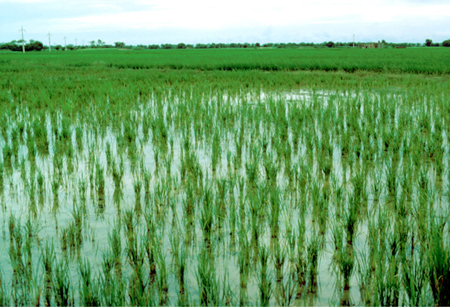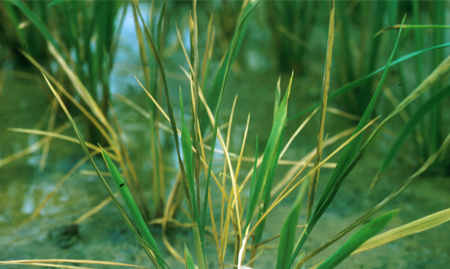Alkalinity
 What it does
What it does
Alkalinity impairs plant growth by restricting water supply to the roots, thus obstructing root development. It results to phosphorus and zinc deficiencies, and possibly iron deficiency and boron toxicity.
Plants have less ability to extract essential nutrients from the soil when damaged by alkalinity.
Why and where it occurs
Alkalinity is relatively rare especially in irrigated rice systems. It can be a problem in rainfed areas with poor rainfall distribution or within irrigated areas with poor water delivery.
It occurs in semiarid region soils and is often associated with salinity.
Alkaline soils have high levels of exchangeable sodium, usually more than 15%.
The high percentage of sodium usually causes soil structural problems, which can affect aerobic or upland crop systems. It can also have a direct effect on some varieties.
How to identify
Check leaves for discoloration and leaf rolling.
 Symptoms show discolored leaves ranging from white to reddish brown, starting from the leaf tips. Leaves can also have senescence or natural drying.
Symptoms show discolored leaves ranging from white to reddish brown, starting from the leaf tips. Leaves can also have senescence or natural drying.
In severe alkaline conditions, discoloration spreads down the leaf giving the plant a scorched appearance.
Its symptoms can be confused with Nitrogen deficiency. Strong alkaline soils also inhibit growth and tillering, causing plants to stunt, and leaves to roll. Alkalinity can also delay flowering and cause whiteheads.
To confirm alkalinity, bring soil and plant sample to a laboratory for testing.
Why is it important
Alkalinity can be a major source of yield and economic loss in rice production.
Although rare in irrigated rice systems, alkalinity damage can occur throughout the growth cycle of the crop.
How to manage
There is currently no practical field management option for alkalinity.